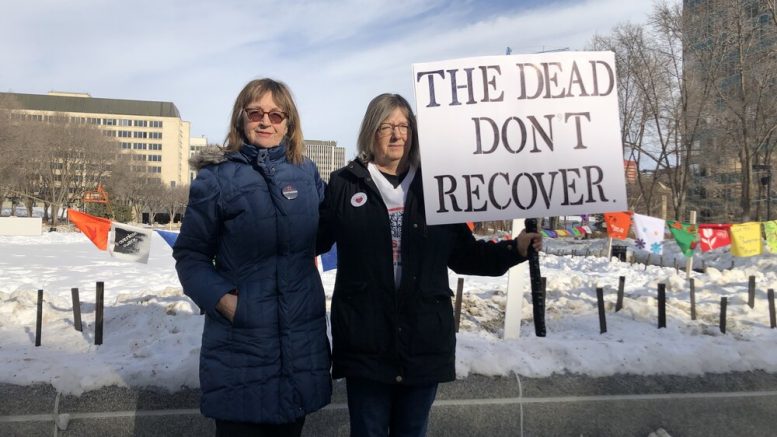By Jeremy Appel, Local Journalism Initiative
(ANNews) – Alberta reached a grim landmark with 179 drug poisoning deaths in April 2023, and more recent EMS response data suggests the problem is getting worse.
The week ending June 26 saw EMS responding to a record high 339 reported overdoses, a significant increase from the previous week, which was at the time a record high of 277. Prior to the week ending June 19, the highest number of calls was 276 in the week ending Nov. 29, 2021.
Prior to the 179 deaths reported for April 2023, the deadliest month for drug poisoning was December 2021, with 175 fatalities, followed closely by November 2021 with 173 deaths, and February 2022 with 171 deaths.
March 2023 reported 168 fatalities, meaning two of the five months with the most drug poisoning casualties occurred this year.
Confederation of Treaty No. 6 Nations Grand Chief Leonard Standingontheroad officially declared the drug poisoning crisis a public emergency on July 11. “If harm reduction isn’t available, our People will die,” Standingontheroad said in reference to policies aiming to reduce the harm inherent in drug use, such as supervised consumption sites and safe supply.
The provincial government’s solution to the crisis, however, has largely consisted of a commitment to build 11 new recovery facilities across the province — including in Enoch Cree Nation, Tsuut’ina Nation, Siksika Nation and Kainai Nation.
Euan Thomson, a Calgary-based harm reduction advocate, told Global News that this approach is excessively narrow, mischaracterizing a “drug poisoning massacre” as an addictions crisis.
“Addiction treatment services are never going to be enough to manage a toxic drug crisis,” said Thomson.
“We’ve stripped away supervised consumption sites, we’ve eliminated what little safe supply existed before and there’s very little options left for people who aren’t ready for abstinence.”
The union representing EMS responders agrees.
“The current focus on recovery only is clearly not working to protect and aid our loved ones, friends and neighbours who are battling addictions,” Health Sciences Association of Alberta president Mike Parker told Global.
“We need to restart and expand harm reduction programs and the wraparound mental health services that go with them.”
Harm reduction advocate Angie Staines told the Edmonton Journal the recent increase in overdose deaths has been “blatantly obvious” to anyone working on the front lines.
“Just go stand Downtown, and look in every corner and you will see ambulances and fire trucks. I have never witnessed anything like it,” said Staines.
She said that if the government continues its narrow recovery-oriented approach, “we’re just going to keep burying people.”
“We need to start giving these people the autonomy to make the choices that are right for them,” Staines added.
“(For) some people the recovery-based program works great. For some people, it doesn’t. Is there anything wrong with that? No.”
At his Drug Data Decoded newsletter on Substack, Thomson outlined four government decisions he believes have contributed to a worsening drug poisoning crisis.
The government eliminated the province’s take-home hydromorphone program, which was the closest equivalent in Alberta to safe supply, where people who use drugs are provided with pharmaceutical grade drugs to ensure the supply isn’t tainted.
Calgary outreach workers told the CBC of the increased prevalence of “tranq dope,” which includes tranquilizers that are immune to the opioid-reversal drug Naloxone.
The government’s decision to send additional police officers to patrol downtown and confiscate drugs also might have played a role in increased drug poisoning deaths, as people become increasingly desperate to find their drug of choice.
According to a July 2023 study in the American Journal of Public Health, drug busts lead to increased overdoses in the vicinity where those busts occurred.
The United Conservative government, Thomson wrote, has also refused to introduce overdose prevention services at homeless shelters or decriminalize simple drug possession.
A December 2021 report from the Alberta government and First Nations Information Governance Centre found that the drug poisoning epidemic has disproportionately impacted First Nations people.
First Nations members represented 22 per cent of all opioid poisoning deaths in Alberta in 2020, despite comprising just six per cent of the province’s population.
Since 2016, the rate of drug poisoning per 100,000 has consistently been higher among First Nations people than non-First Nations people.
While the rate of opioid poisoning deaths per 100,000 people decreased among non-First Nations people in 2019 to 11.3 from 16.1, it increased among First Nations to 69.5 from 61.7.
The rate for both groups increased in the first half of 2020, but it increased more among First Nations people. For non-First Nations people it increased to 19.5 from 11.3, but for First Nations people it increased to 142.8 from 69.5.
APTN News reported on July 7 that the drug poisoning crisis has contributed to a seven-year life expectancy decrease for First Nations people from 2015 to 2021.



Be the first to comment on "Alberta sees record high deaths, EMS dispatches from drug poisoning"